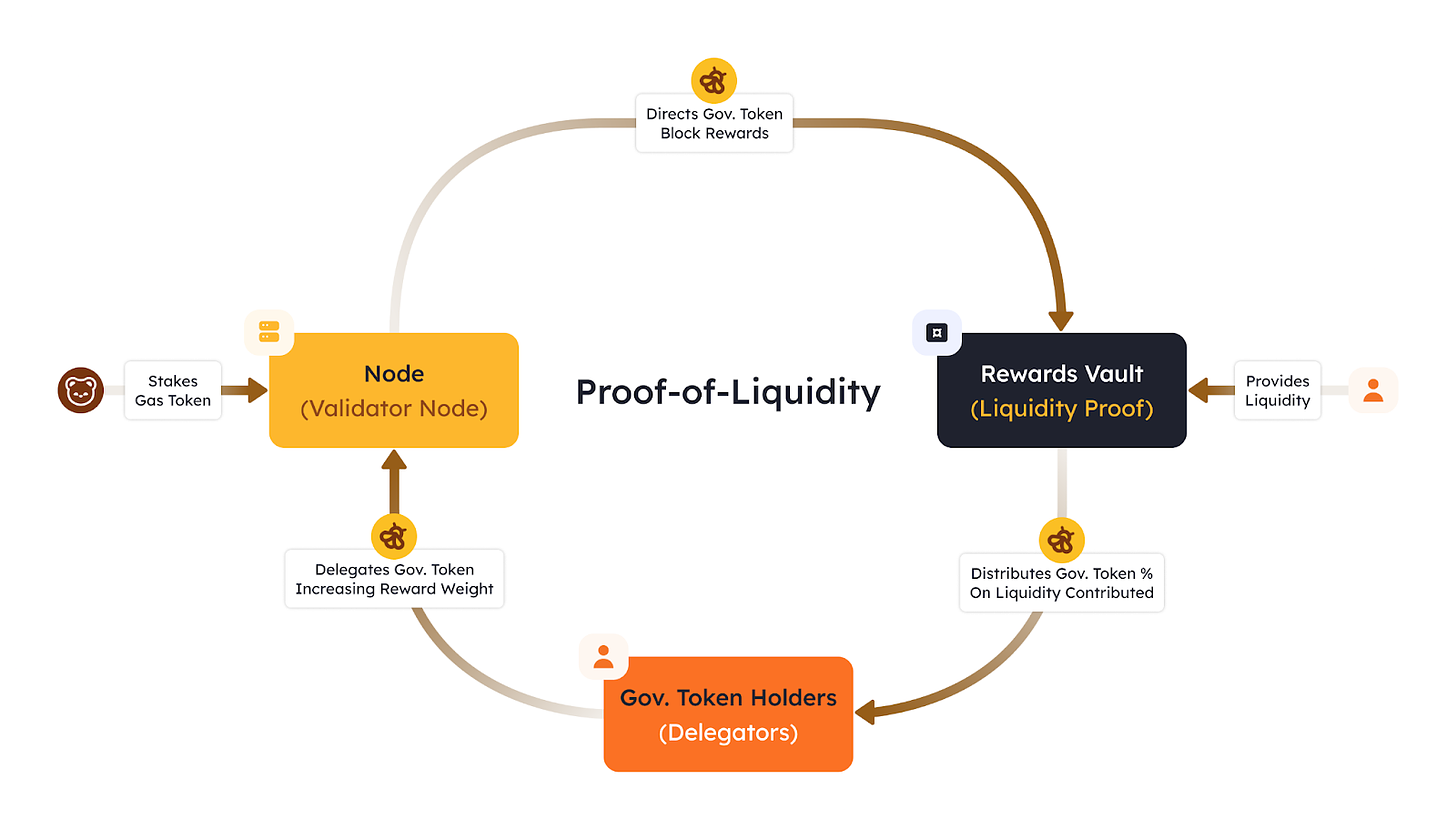
Discover more from Francesco's Joint
The Year of the Bera
An introduction to Berachain, going beyond the hype and translating the technical intricacies of its Protocol Owned Liquidity.
After a year of unfulfilled promises for a new bull market, crypto has a new spirit animal: the Bera.
In crypto's highly challenging habitat, one project stands taller than the rest.
This article introduces Berachain, going beyond the hype and translating the technical intricacies of its Protocol Owned Liquidity (POL) mechanism to provide a better understanding of its ecosystem.
Que es Berachain?
Berachain is a novel Layer 1 (L1) blockchain.
Contrary to the belief that the development of L1 solutions has reached its zenith, Berachain, along with Monad, seeks to revitalize and redefine what L1 can offer.
This approach contrasts sharply with the current trend, where most projects either focus on building Layer 2 (L2) solutions atop Ethereum or develop as independent app chains and Layer 3 (L3) networks.
The decision to innovate at the L1 level is deeply intertwined with Berachain's most significant advancement—their novel POL consensus mechanism.
Differentiating POL and PoL
Readers may recall the concept of Protocol Owned Liquidity (PoL) from the Olympus DAO era, a notion that may evoke mixed emotions.
However, the POL introduced by Berachain represents a distinct and innovative concept that necessitates clear differentiation:
POL= proof of liquidity
PoL= protocol owned liquidity
The Evolution of Consensus
Since the advent of Bitcoin, blockchain networks have tried to address the blockchain trilemma, balancing security, speed, and decentralization.
Different consensus mechanisms have been employed to align the incentives of network participants in a decentralized network.
Initially, Bitcoin utilized Proof of Work (POW), requiring miners to invest in hardware and bear electricity costs to solve cryptographic puzzles and mine new Bitcoins.
POW serves as a form of cryptographic proof wherein one party demonstrates to others that a specific amount of computational effort has been expended.
The POW model, initially adopted by Ethereum and others, became the most viable method for coordinating incentives in a decentralized network.
However, as the hardware costs and energy consumption associated with POW grew, alongside concerns over the centralization of mining power and long-term sustainability, the industry began shifting towards Proof of Stake (POS) as the preferred consensus mechanism.
In POW, validators must purchase physical hardware to mine Bitcoin. In contrast, POS networks (such as Ethereum) require validators to have "skin in the game" by staking a certain amount of the network's native tokens (e.g., 32 ETH in Ethereum) to participate in block creation and transaction validation.
Validators' incentives are aligned with the network's correct functioning: in case of malicious behavior, validators will lose (get slashed) a portion of their ETH stake.
Transitioning from POS to POL
While the POS model ensures validators have a stake in the game, it fails to align their interests with protocols in collaborating towards a common goal.
At least at the consensus level, there is a notable lack of alignment or deeper involvement of:
Protocols to ensure the network works correctly
Validators to ensure that protocols drive economic activity to the network
The absence of this collaboration within the consensus mechanism also raises questions about the role of users.
This is where Berachain's POL consensus comes into play.
Building upon POS, the POL consensus incorporates an incentive system at the consensus level strategically designed to align the interests of all network participants—validators, applications, and users.
The use of incentives is well-established in the cryptocurrency domain, with notable examples such as Curve, Convex, and Redacted demonstrating the power of incentives to align interests and scale products.
However, Berachain is pioneering integrating a bribing system directly into the consensus model, ensuring that collaboration among network actors is ingrained within the network's infrastructure.
Practical Implications of POL
Under this model, Berachain is building a network where liquidity and security scale proportionally as the network grows, fostering alignment in the community from the outset.
The POL system incentivizes all participants, with a particular emphasis on validators, whose active involvement is crucial to the network's success.
Understanding the balance of incentives achieved through POL requires an introduction to Berachain’s token model:
BGT: The Bera Governance Token (BGT) is the fundamental piece of the POL model. It is non-transferable and can only be earned by participating in the POL. BGT is more than a simple governance token used to vote, representing the most significant share of POL rewards: users delegate BGT to validators, and new BGT are only emitted as rewards for validators proposing a valid block, which they then distribute to applications according to the bribes received. Users can only get BGT by adding liquidity to LPs with BGT emissions – once received, they can decide whether to use it or burn it for BERA.
BERA: The gas token of Berachain, which is transferable and must be staked by network participants to become active validators.
HONEY: Berachain’s native USD-pegged collateral stablecoin can be minted by depositing different whitelisted collateral into a vault.
The Berachain Flywheel
The "modular liquidity" of Berachain shifts the ecosystem from a zero-sum game to a collaborative environment, leading to an ecosystem-wide Flywheel effect:
Validators interact directly with users, maximizing the BGT delegated to them. Users delegate their BGT to validators, and the more BGT they have, the more rewards they will get. Validators earn a fee from those rewards.
Applications are working together to get bigger BGT rewards to their pools in order to encourage users to add liquidity rather than compete
Users can choose different options once they deposit in a pool, which fluctuates over time. Their rewards will depend on their share of total assets staked in a pool and the amount of BGT rewards validators emit to the gauge.
Ultimately, validators determine the distribution of BGT emissions across pools and protocols, and their strategies may vary.
Protocols can also attract more BGT rewards by incentivizing validators with native token rewards - read bribes. Let’s have a practical example:
Validators point their BGTs to the LPs of the protocol.
Let's say you are FrancescoProject and you have FRAcoin. You want to have a robust LP on FRAcoin/Bera.
To do so, you will decide to bribe validators with X amount of FRAcoin, and then the validator will send his BGT to the FRAcoin/Bera LP.
Users will want to earn BGT and will therefore add liquidity to that LP
This model necessitates close coordination among validators, applications, and users to incentivize all parties. Here’s how Berachain participants take part in the flywheel.
Validators: validators distribute BGT rewards according to their Rewards Weight, proportional to the amount of BGT delegated to them. The rewards of validators also consist of bribes from ecosystem applications + rewards from block captured value (a fee on total rewards, e.g. BERA from gas, HONEY from trading fees, etc.)
Aside from securing the network, validators have to:Maximize their BGT delegation
Direct BGT incentives
Users vote with their wallets: They deposit liquidity into a whitelisted pool and receive LP tokens. They can stake these in a specific gauge to earn BGT, which is then delegated to validators.
Ecosystem Projects: anyone can tap into Berachain native emissions as a source of yield. Applications can send bribes to delegates, leading to positive feedback loops incentivizing liquidity for specific gauges and more rewards distributed to these applications (e.g. Users would see this and opt to deposit more liquidity into the gauge, earning BGT and increased rewards relative to other gauges).
Within this POL framework, the role of validators becomes increasingly significant.
They can establish direct partnerships with applications on Berachain, leveraging bribes to diversify their revenue streams. For instance, validators might collaborate with protocols to enhance user incentives, increasing LP participation.
Therefore, the delegation of BGT to validators requires careful consideration: they play a pivotal role within the ecosystem due to their interconnectedness with applications and users.
While the POS model ensures that validators have a stake within the ecosystem, POL extends this alignment, harmonizing the interests of all network participants at the consensus level.
Whereas protocols like Curve have utilized incentives to direct emissions to a single pool, the Berachain ecosystem operates collectively to determine the optimal flow of value, resulting in a more comprehensive ecosystem Flywheel.
Addressing Traditional Liquidity Provider Challenges
The POL consensus also addresses the traditional challenges faced by Liquidity Providers (LPs) by offering multiple reward streams:
BGT distribution from Validators
LP rewards
Additional rewards and incentives from bribes
Aside from receiving rewards, LPs also increase their participation in governance by receiving BGT.
In addition to receiving rewards, LPs gain increased governance participation through BGT, further enhancing their role within the network.
POL also contributes to PoL by enabling Berachain applications to tap into the chain's native emissions as a yield source rather than paying LPs to rent liquidity.
This approach simplifies the application process to bootstrap liquidity and deposits by aligning with validators and offering higher bribes to attract liquidity.
In turn, this can contribute to developing consumer-facing applications beyond DeFi. These applications will be less dependent on mercenary capital and can tap into the ecosystem liquidity to kickstart their operations.
The Berachain POL model posits that liquidity will follow, provided sufficient incentives exist to delegate BGT and participate in the network.
Broader Implications and Future Considerations
Good tech can only get you so far.
While technological innovation is crucial, Berachain’s approach sets itself apart by focusing on a positive feedback loop within its ecosystem to ensure sustained growth and collaboration.
The most scarce resource within crypto is users.
With many competing for the same pool of users, the POL consensus ensures that Berachain users will enjoy better rewards and participation within the ecosystem since its inception. There have been many cases of new L2 launching and adopting predatory tactics against users, who were forced to lock their liquidity for months in a new ecosystem without any guarantee of rewards or decisional power.
Berachain rewrites this script so that users are not only exit liquidity but active and fundamental participants in this space, with a decisional role in determining where liquidity and value should flow within the ecosystem.
While all previous incentive programs and closed-loop incentive systems were only beneficial to participants, POL is the first “extendable incentive system at the protocol level”, aiming to ensure the network's long-term success and longevity.
This fits the Fat Bera Thesis, where “the applications built with PoL at the forefront will capture the majority of value in the Berachain ecosystem”.
Currently, the model highly depends on the relationship between Berachain validators and BGT delegators. Will this last once the network is live?
Many have also highlighted the vital role of validators within the ecosystem.
Will they eventually become too powerful?
Validators' reliance on block production could also possibly become a single point of failure: what if demand for block creation falls?
Last but not least, many have raised the question of decentralization.
While Berachain mentions that “Proof of liquidity is for the people”, with most validators and liquidity pools needing whitelisting, will the system work as intended? Or is it just another way of concentrating power in a few hands?
Most of this model's theoretical assumptions will have to be confirmed in practice.
The success of the POL model will depend on its real-world implementation and the continuous efforts to ensure decentralization and sustainability.
















That is absolutely brilliant and the idea is fresh and I think we need some smokey the bear now and you can have multiple other spin off coin that keep those same principles in my yet hit different spectrums customer wise